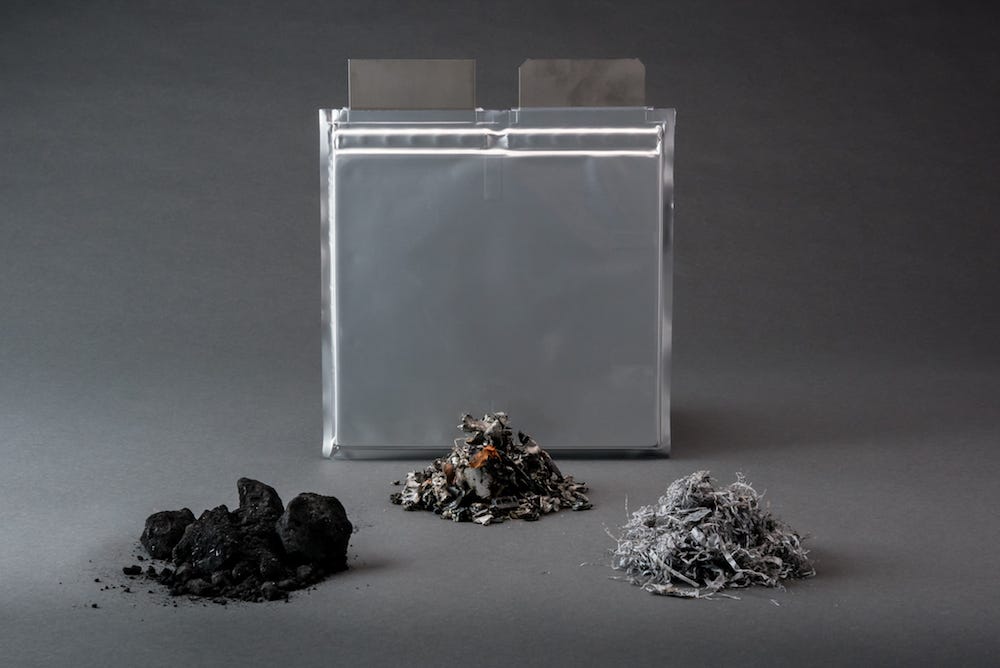How much of your EV battery can *actually* be recycled?
We don't know. But a science-industry team wants to find out
Climate technologies require enormous amounts of metal. I’m Ian Morse, and this is Green Rocks, a newsletter that doesn’t want dirty mining to ruin clean energy.

Battery recycling has become a common headline, and scientists could be credited for that. Policies and companies leaning on the energy transition are set to produce millions upon millions of lithium-ion batteries. Some will be used for electric vehicles (EVs), some for grid storage, and others for industrial uses.
These batteries aren’t designed to last forever. Batteries for purchase now will likely meet the end of their primary life in 2030, at least. At that point, what happens? They can be thrown away, reused, or —
Recycled. But reusing a battery is not straightforward. Batteries as they are currently designed put heavy strains on recyclers to get what they can from used batteries. As a result, people may only be able to recycle a small part of each battery.
Ethan Alter at the newsletter Intercalation Station first raised this topic with me a few months ago. Both recycling and battery companies have been claiming to be able to recover up to 98% of some metals from batteries. But their statements remain vague, people are left to trust that these figures are both verifiable and meaningful.
For example, in April, Li-Cycle said its recycling methods achieve “around 95% recovery of all the materials used in lithium batteries.” Later in the year, in joint press releases made by GM and Li-Cycle, the companies said that they will recycle 95% of the “cobalt, nickel, lithium, graphite, copper, manganese and aluminum,” but did not mention the fate of the plastics and organic solvents found in batteries, which could be assumed to be included in the definition of ‘all.’
Redwood Materials, which has partnered with Tesla, claimed in 2020 that they could recover “between 95 and 98 percent of a battery’s nickel, cobalt, copper, aluminum, and graphite, and more than 80 percent of its lithium.” Tesla similarly said in its annual report that it “already begun implementing an in-house, closed-loop recycling system that will ensure 100% of Tesla batteries received are recycled and up to 92% of their raw metals reused.” Tesla battery packs are notoriously difficult to recycle, and most are shredded and burned into a black mass from which only expensive metals can be recovered.
Top battery scientists in the US are now teaming up with an industry group to give some clarity to these statements, which could streamline collection and recycling for this critical climate technology.
“That’s the goal, to be able to certify those statements,” says Jonathan Stewart, who works with the National Electrical Manufacturers Association. Stewart had read the predictions that millions of batteries will need to be recycled, and after discussing with NEMA members about how to contribute, “this was the idea that came out,” he told Ethan and me in an interview. NEMA is cooperating with Argonne National Laboratory, which may be the most-quoted lab on battery recycling. (I’ve gone to them a few times.)
Climate policies are planning for the massive rollout of EVs, and North America constitutes one of the biggest market for these products — as well as where an energy transition is most needed. But battery recycling lags behind other major EV markets. The EU is currently writing rules and China has been pushing recycling since at least 2018. While Biden has made recycling a part of his EV agenda, regulations are still a ways off, and building recycling networks is left to companies.
The NEMA-Argonne partnership aims to tackle one part of this puzzle. NEMA plans to develop a standard, which can be used by manufacturers, recyclers, collectors, and consumers, to understand what materials from batteries can actually be reused. The standard will target stationary and industrial batteries, but “the urgency now is around EV batteries,” says Stewart, who is the Industry director of Utility Products and Systems division.
“NEMA hopes this Standard will be one step towards developing a robust collection and recycling infrastructure in North America that will be adequate to handle the number of batteries reaching their end of life,” Stewart says.
The standard will help close a gap in the recycling chain: collection. Currently, if drivers want to recycle their EV batteries they may seek out a collector, which is often hard to find. Collectors would then sell these batteries to recyclers, who will pay them. However, if collectors are unsure about how much value can come from each battery -- linked to how much metal can be recovered and reused -- then they may not be so keen to accept every battery.
“It’s no secret, right,” Stewart says. “The manufacturers... can say, ‘Hey, X amount of this cell or this battery is recyclable.' But as a collector, are you going to take their word for it or do you want to see some third party verification?”
With more widespread information about batteries, players in the recycling field can feel more comfortable buying and selling used batteries. In a field as erratic and nascent as batteries, standards have the potential to ameliorate concerns that players won’t be able to offset costs.
“That way, everybody is singing off the same sheet of music,” Stewart says. He isn’t sure what the standard will look like in the end, and the team may also explore designs and labeling.
Anyone who’s interested in creating the standard has a chance to participate, Stewart says. Companies like EV and battery makers and recyclers will have a seat at the table, but the door is also open to civil society, government, scientists and others. Fees for participation are required. The final standard will be agreed by consensus among voting members.







